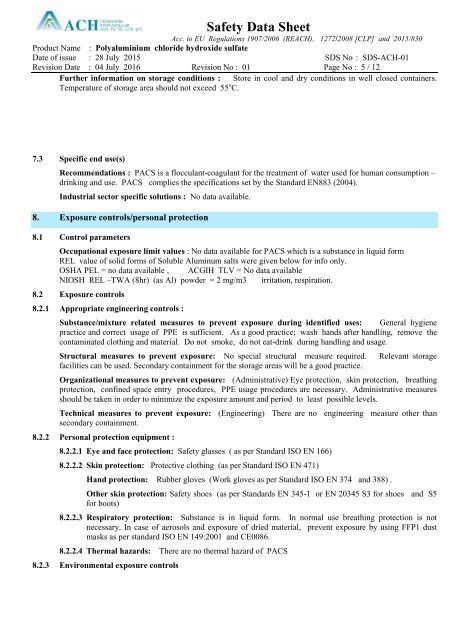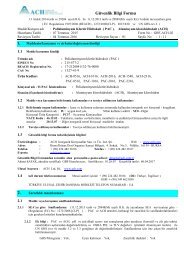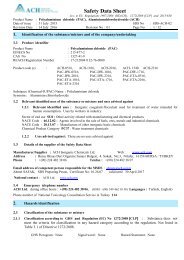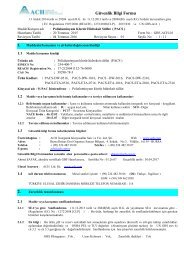PACS MSDS EN
Create successful ePaper yourself
Turn your PDF publications into a flip-book with our unique Google optimized e-Paper software.
Safety Data Sheet<br />
Acc. to EU Regulations 1907/2006 (REACH), 1272/2008 [CLP] and 2015/830<br />
Product Name : Polyaluminium chloride hydroxide sulfate<br />
Date of issue : 28 July 2015 SDS No : SDS-ACH-01<br />
Revision Date : 04 July 2016 Revision No : 01 Page No : 5 / 12<br />
Further information on storage conditions : Store in cool and dry conditions in well closed containers.<br />
Temperature of storage area should not exceed 55 o C.<br />
7.3 Specific end use(s)<br />
Recommendations : <strong>PACS</strong> is a flocculant-coagulant for the treatment of water used for human consumption –<br />
drinking and use. <strong>PACS</strong> complies the specifications set by the Standard <strong>EN</strong>883 (2004).<br />
Industrial sector specific solutions : No data available.<br />
8. Exposure controls/personal protection<br />
8.1 Control parameters<br />
Occupational exposure limit values : No data available for <strong>PACS</strong> which is a substance in liquid form<br />
REL value of solid forms of Soluble Aluminum salts were given below for info only.<br />
OSHA PEL = no data available , ACGIH TLV = No data available<br />
NIOSH REL –TWA (8hr) (as Al) powder = 2 mg/m3 irritation, respiration.<br />
8.2 Exposure controls<br />
8.2.1 Appropriate engineering controls :<br />
Substance/mixture related measures to prevent exposure during identified uses: General hygiene<br />
practice and correct usage of PPE is sufficient. As a good practice; wash hands after handling, remove the<br />
contaminated clothing and material. Do not smoke, do not eat-drink during handling and usage.<br />
Structural measures to prevent exposure: No special structural measure required.<br />
facilities can be used. Secondary containment for the storage areas will be a good practice.<br />
Relevant storage<br />
Organizational measures to prevent exposure: (Administrative) Eye protection, skin protection, breathing<br />
protection, confined space entry procedures, PPE usage procedures are necessary. Administrative measures<br />
should be taken in order to minimize the exposure amount and period to least possible levels.<br />
Technical measures to prevent exposure: (Engineering) There are no engineering measure other than<br />
secondary containment.<br />
8.2.2 Personal protection equipment :<br />
8.2.2.1 Eye and face protection: Safety glasses ( as per Standard ISO <strong>EN</strong> 166)<br />
8.2.2.2 Skin protection: Protective clothing (as per Standard ISO <strong>EN</strong> 471)<br />
Hand protection: Rubber gloves (Work gloves as per Standard ISO <strong>EN</strong> 374 and 388) .<br />
Other skin protection: Safety shoes (as per Standards <strong>EN</strong> 345-1 or <strong>EN</strong> 20345 S3 for shoes and S5<br />
for boots)<br />
8.2.2.3 Respiratory protection: Substance is in liquid form. In normal use breathing protection is not<br />
necessary. In case of aerosols and exposure of dried material, prevent exposure by using FFP1 dust<br />
masks as per standard ISO <strong>EN</strong> 149:2001 and CE0086.<br />
8.2.2.4 Thermal hazards: There are no thermal hazard of <strong>PACS</strong><br />
8.2.3 Environmental exposure controls
















